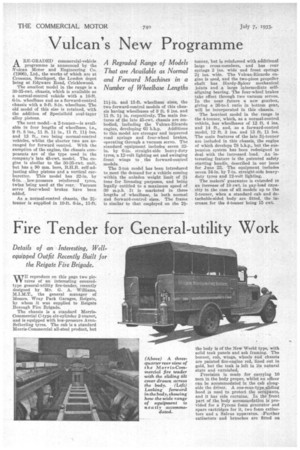Vulcan's New Programme
Page 42

If you've noticed an error in this article please click here to report it so we can fix it.
A Regraded Range of Models That are Available as Normal and Forward Machines in a Number of Wheelbase Lengths
ARE-GRADED commercial-vehicle programme is announced by the iVnleari Motor and Engineering Co. (1906), Ltd., the works of which are at Crossens, Southport, the London depot being at Edgware Road, Cricklewood.
The smallest model in the range is a 30-35-cwt. chassis, which is available as a normal-control vehicle with a 10-ft. 6-in, wheelbase and as a forward-control chassis with a 9-ft. 8-in. wheelbase. The old model of this size is retained, with the addition of SpecieHold oval-taper alloy pistons.
The next model—a 2-tonner—is available in four lengths of wheelbase, i.e., 9 ft. 8 ins., 11 ft. 1+ in., 11 ft. 11+ ins. End 13 ft., two being normal-control vehicles, vvhilst the shorter two are arranged for forward control. With the exception of the engine, the chassis components are of the type used in the company's late 45-cwt. model. The engine is similar to the 30-35-cwt. unit, but has a 90 mm. bore, B.H.B. self-adjusting alloy pistons and a vertical carburetter. This model has 32-in. by 6-in, low-pressure reinforced tyres, twins being used at the rear. Vacuum servo four-wheel brakes have been added.
As a normal-control chassis, the 21tonner is supplied in 10-ft. 6-in., 11-ft. 111-in. and 13-ft. wheelbase sizes, the two forward-control models of this chassis having wheelbases of 9 ft. 8 ins. and 11 ft. 1-+ in. respectively. The main features of the late 45-cwt. chassis are embodied, including the Vulcan-Ricardo engine, developing 63 blip. Additions to this model are stronger and improved road springs and four-wheel brakes, operating through a vacuum servo. The standard equipment includes seven 32in. by 6-in. straight-side heavy-duty tyres, a 12-volt lighting set and swinging front wings to the forward-control models.
The 3-ton model has been introduced to meet the demand for a vehicle coming within the unladen weight limit of 21 tons for licensing purposes, and being legally entitled to a maximum speed of 30 m.p.h. It is marketed in three lengths of wheelbase, in both normal and forward-control sizes. The frame is similar to that employed on the 21 tanner, but is reinforced with additional large cross-members, and has • rear springs 3 ins, wide and front springs 2+ ins. wide. The Vulcan-Ricardo engine is used, and the two-piece propeller shaft has Hardy-Spicer mechanical joints and .a large intermediate selfaligning bearing. The four-wheel brakes take effect through two vacuum servos. In the near future a new gearbox, giving a 36-to-1 ratio in bottom gear, will be incorporated in this chassis.
The heaviest model in the range is the 4-tonner, which, as a normal-control vehicle, has wheelbases of 12 ft. 4 ins. and 14 ft., and, as a forward-control model, 12 ft. 3 ins. and 13 ft. 11 ins. The main features of the late 3+-tonner are included in this chassis, the engine of which develops 78 b.b.p., but the
suspension system has been redesigned to deal with the increased load. An interesting feature is the patented safety starting handle, described in our issue for June 23. The equipment includes seven 34-in. by 7-in, straight-side heavyduty tyres and 12-volt lighting.
The makers' guarantee is extended to an increase of 10 cwt. in pay-load capacity in the case of all models up to the 3-tonner, when a standard cab and detachable-sided body are fitted, the increase for the 4-tonner being 15 cwt.




































































































